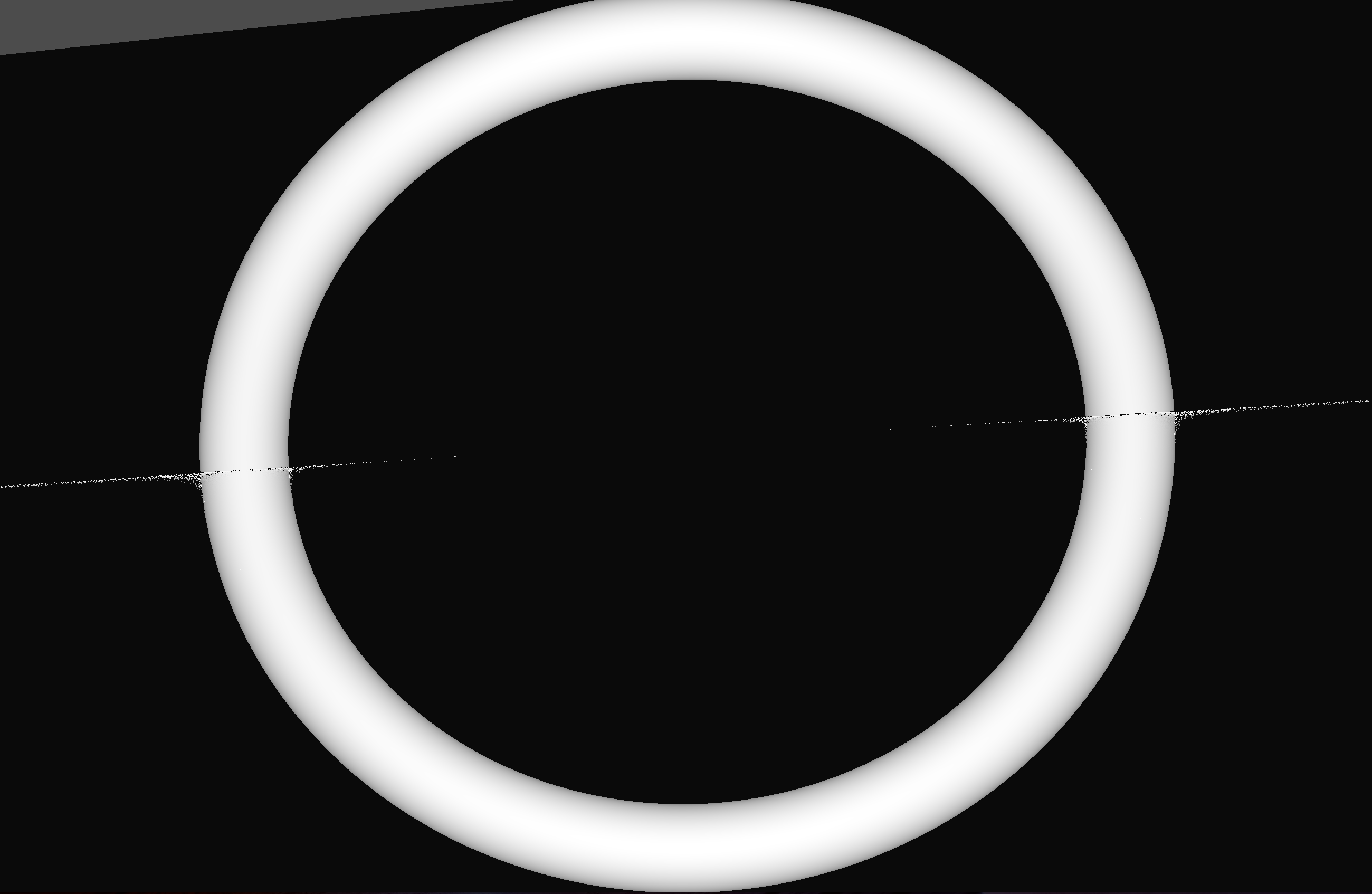Opticks : GPU Optical Photon Simulation for Particle Physics with NVIDIA OptiX
Opticks : GPU Optical Photon Simulation for Particle Physics with NVIDIA® OptiX™
Simon C Blyth, National Taiwan University — https://bitbucket.org/simoncblyth/opticks — Sept 2017, SDU
Opticks Benefits
Opticks > 1000x Geant4 (*)
GPU massive parallelism eliminates bottleneck.
- optical photon simulation time --> zero
- optical photon CPU memory --> zero
[zero: effectively, compared to rest of simulation]
More Photons -> More Benefit
- Neutrino detectors can benefit the most, eg JUNO and Dayabay
http://bitbucket.org/simoncblyth/opticks
(*) core extrapolated from mobile GPU speed
Outline
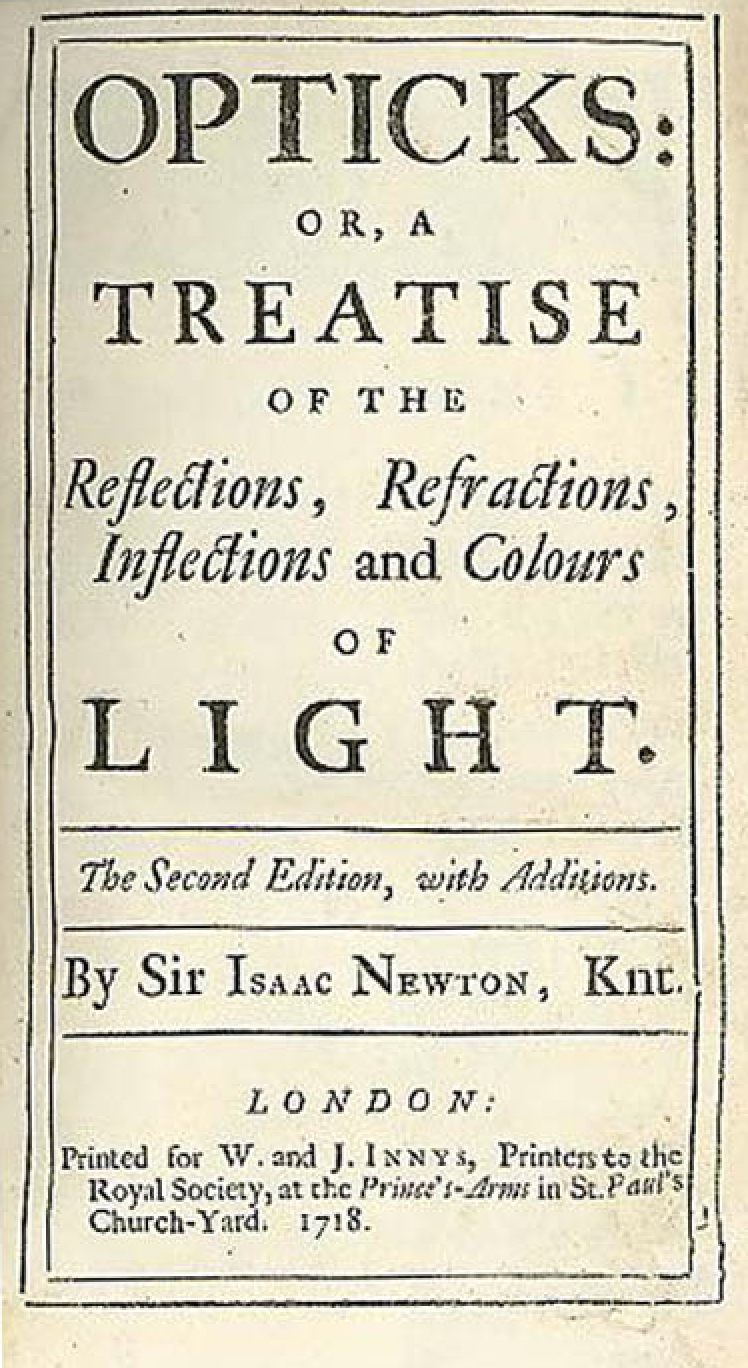
- Problem and approach to solving
- Optical Photon Simulation problem
- Hybrid solution : Geant4 + Opticks
- NVIDIA OptiX Ray Tracing Engine
- Opticks : optical photon simulation with NVIDIA OptiX
- geometry workflow : geocache, GPU textures
- large geometry techniques, geometry modelling
- Geant4/Opticks event workflow
- Validation, performance comparisons
- Summary
Optical Photon Simulation Problem...
JPMT Before Contact 2
Optical Photon Problem
- Cosmic muon backgrounds
- many millions of optical photons in Daya Bay (~10x more in JUNO)
- optical propagation dominates Geant4 CPU time, ~99% JUNO, ~95% Daya Bay
- severe CPU memory constraint
Optical photons:
- produced by Cerenkov+Scintillation processes
- yield only Photomultiplier hits
Isolated nature -> easily separated propagation
Hybrid Solution Possible : Geant4 + Opticks
Ray Traced Image Synthesis ≈ Optical Photon Simulation
OptiX Pixel Calculation
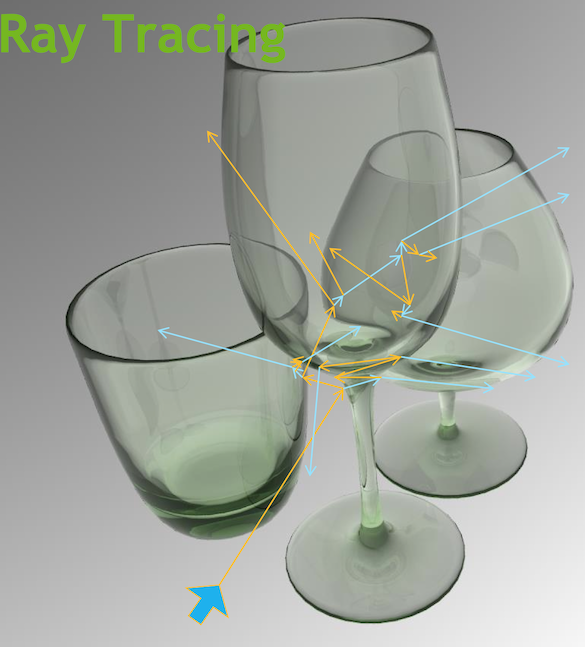
- Geometry, light sources, optical physics ->
- pixel values at image plane
- photon parameters at detectors (eg PMTs)
- Ray tracing has many applications :
- advertising, design, entertainment, games,...
- BUT : most ray tracers just render images
- Ray-geometry intersection
- hw+sw continuously optimized over 30 years
- performance > 100M intersections per second per GPU
- NVIDIA OptiX
- general geometry intersection API
- OptiX is to ray tracing what OpenGL is to rasterization
- rasterization
- project 3D primitives onto 2D image plane, combine fragments into pixel values
- ray tracing
- cast rays thru image pixels into scene, recursively reflect/refract with geometry intersected, combine returns into pixel values
NVIDIA OptiX 1
NVIDIA OptiX 2
NVIDIA® OptiX™
http://developer.nvidia.com/optix
- no rendering assumptions
- just accelerates ray-geometry intersections
- compiler optimized for GPU ray tracing
- regular improvements, new GPU tuning
- NVIDIA expertise on GPU/multi-GPU usage
- ~linear scaling with cores across GPUs
- free to acquire, use, distribute non-commercially
- simple : single-ray programming model

https://research.nvidia.com/publication/optix-general-purpose-ray-tracing-engine
OptiX Performance Scaling with GPU cores
Performance Linearity with CUDA cores
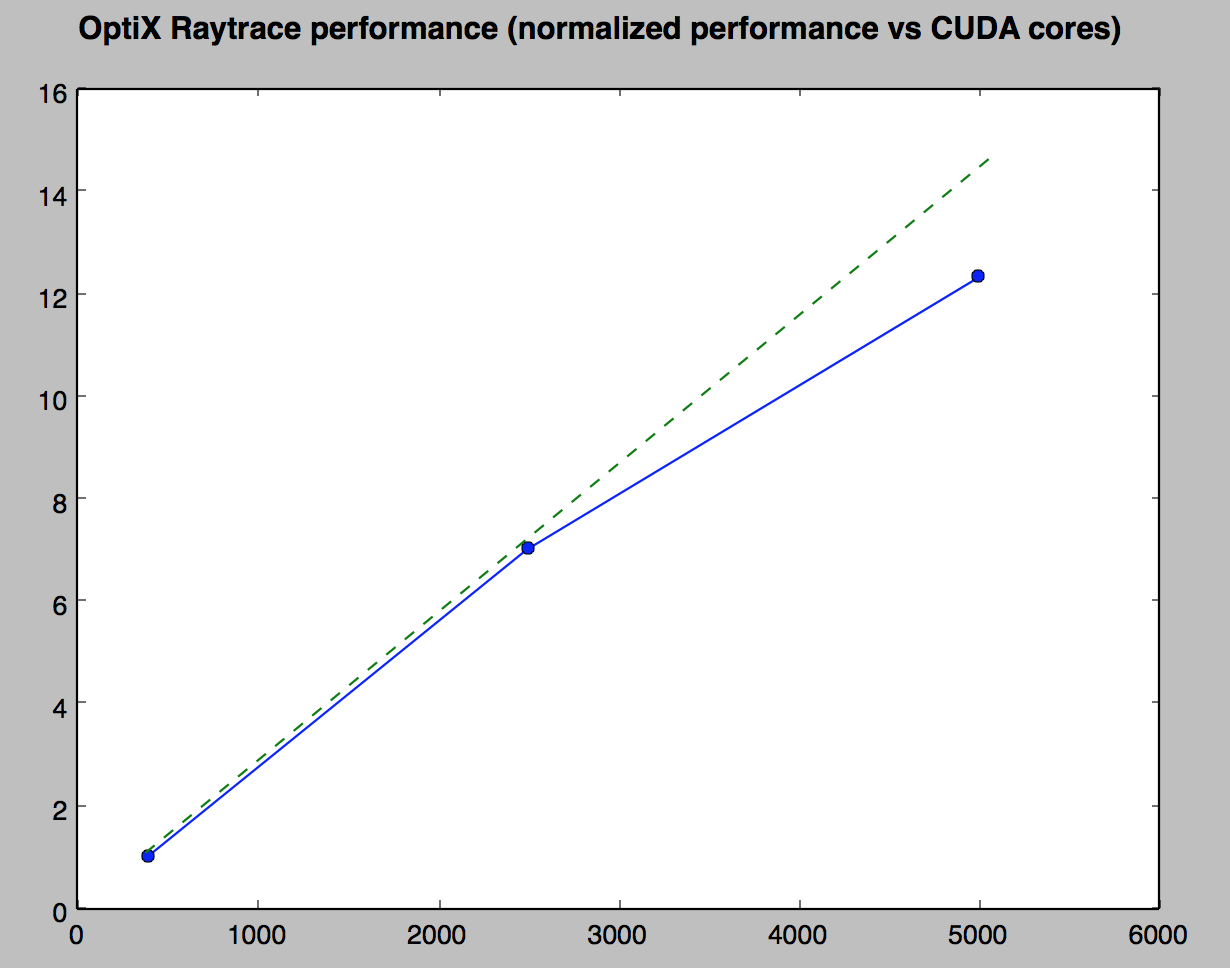
OptiX sample rendering with 2 GPU IHEP workstation,
- 2 Tesla K20m (4992 cores) 28.0 ms/f
- 1 Tesla K20m (2496 cores) 49.1 ms/f
- 1 GeForce GT 750m (384 cores) 345.1 ms/f
Performance linear with GPU cores, compared to laptop:
- 13x cores, 12x performance
- performance scales across GPUs
Benefit from multiple GPUs with no development effort.
OptiX Programming Model : raytrace pipeline made from CUDA programs
OptiX Control Flow
- Yellow: User supplied, Blue: OptiX internals
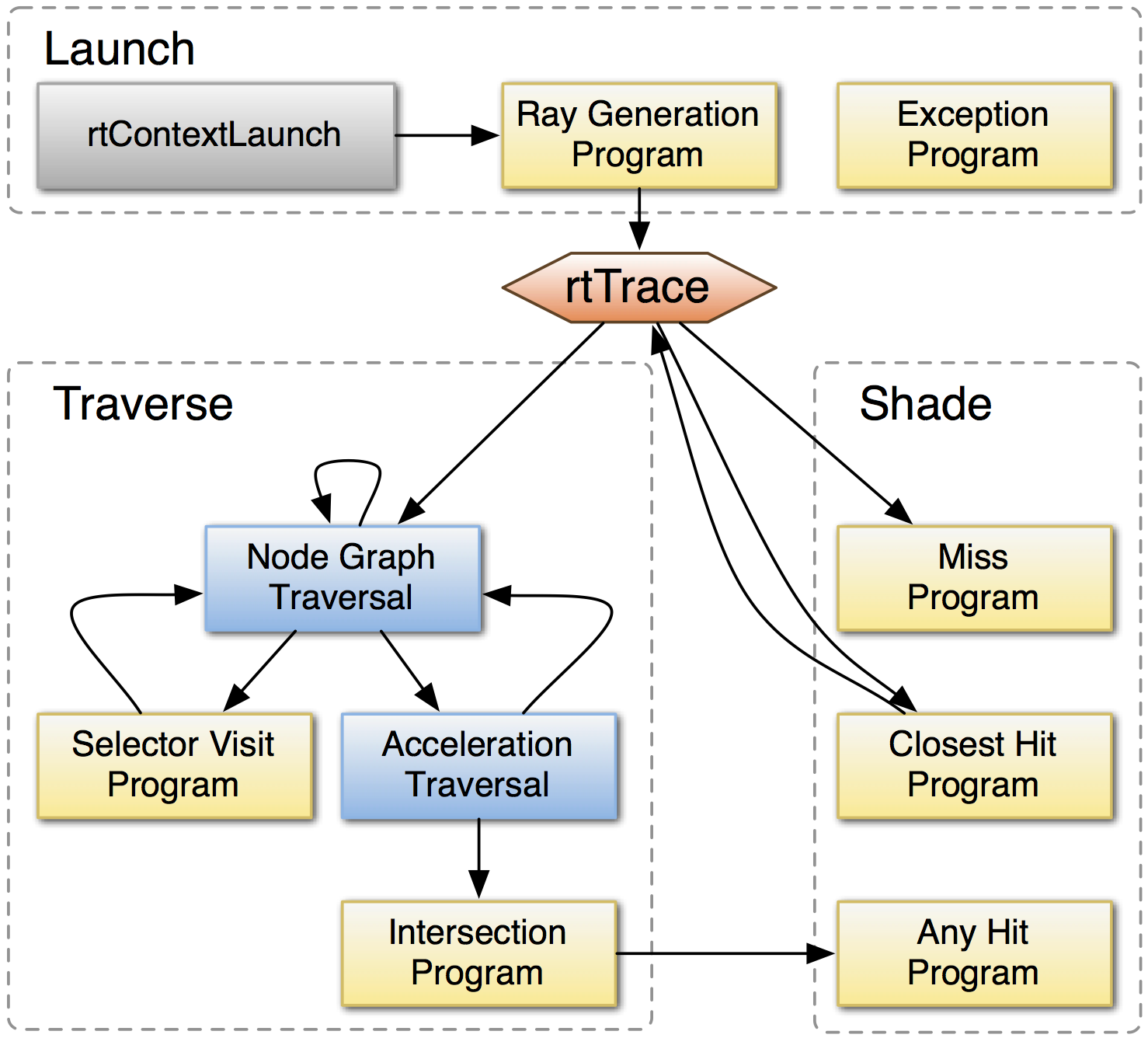
OptiX provides a ray tracing pipeline analogous to OpenGL rasterization pipeline.
OptiX programs used by Opticks photon simulation
- Ray Generation
- coordinate: generate, propagate, write hits
- Geometry Intersection
- mesh triangle or analytic CSG tree intersection
- Closest Hit
- pass intersect to generation (distance, normal, identity)
Handled by NVIDIA OptiX:
- acceleration structure creation + traversal
- instanced sharing of geometry + acceleration structures
- domain optimized combination of CUDA programs into kernel
- cross GPU work scheduling
Everything else : user supplied
https://research.nvidia.com/sites/default/files/publications/Parker10Optix_1.pdf
Opticks : GPU Optical photon simulation with NVIDIA OptiX. How ?
G4 "Context" -> GPU
Straightforward : just translation
- translation of optical physics to CUDA
- interleave material/surface properties into GPU textures
Difficult : novel development was required
- develop general GPU CSG tree intersection
- develop auto conversion from GDML
- ~10 CUDA ray-primitive intersection programs: sphere, box, cone, torus, ...
Optical Photon Generation
- translate G4Cerenkov, G4Scintillation optical photon generation loop into parallel CUDA form (only generation loop ported)
- "genstep" parameters collected, copied to GPU for propagation at end of event
Optical Photon Propagation + Scintillator Reemission
- CUDA port of G4OpAbsorption, G4OpRayleigh, G4OpBoundaryProcess (small subset for optical surfaces in use)
- scintillator reemission handled as fraction of bulk absorbed being "reborn" within same GPU thread
Collect PMT hits into standard G4 Hit collections
- just photomultiplier hits copied to CPU
Requires : Geometry converted into GPU appropriate form
- geometry serialized into buffers, uploaded to GPU at initialization
- CUDA intersect + bounding box programs using geometry buffers communicate geometry to OptiX
- general ray intersection with CSG trees implemented within OptiX primitive
Geometry : Geant4 -> Opticks Geocache -> OptiX GPU
Volumes -> Boundaries
Ray tracing favors Boundaries
Material/surface boundary representation (4 indices)
- outer material (parent)
- outer surface (inward photons, parent -> self)
- inner surface (outward photons, self -> parent)
- inner material (self)
Primitives labelled with unique boundary index
- ray primitive intersection -> boundary index
- texture lookup -> material/surface properties
GPU textures also used for:
- scintillator reemission wavelength generation
- standard illuminant Plankian wavelength gen
Geocache -> few seconds startup, instead of few minutes
- Benefit from constant nature of Geometry
- Once per geometry : Export, Construct Geocache
- G4 Export : Analytic (GDML) + Triangulated (G4DAE)
- parse G4DAE + GDML into volume trees
- find repeated geometry "instances" (progeny digests)
- construct material/surface property arrays
- full geometry written to NumPy .npy serialization files
- Every run : upload geocache + make acceleration structure
- load geocache .npy files
- upload OptiX textures to GPU
- upload OptiX geometry buffers to GPU
- intersect + bounding box programs -> OptiX acceleration structures
- complex shapes modelled via CSG boolean combinations
Opticks : GPU Geometry starts from ray-primitive intersection
- 3D parametric ray : ray(x,y,z;t) = rayOrigin + t * rayDirection
- implicit equation of primitive : f(x,y,z) = 0
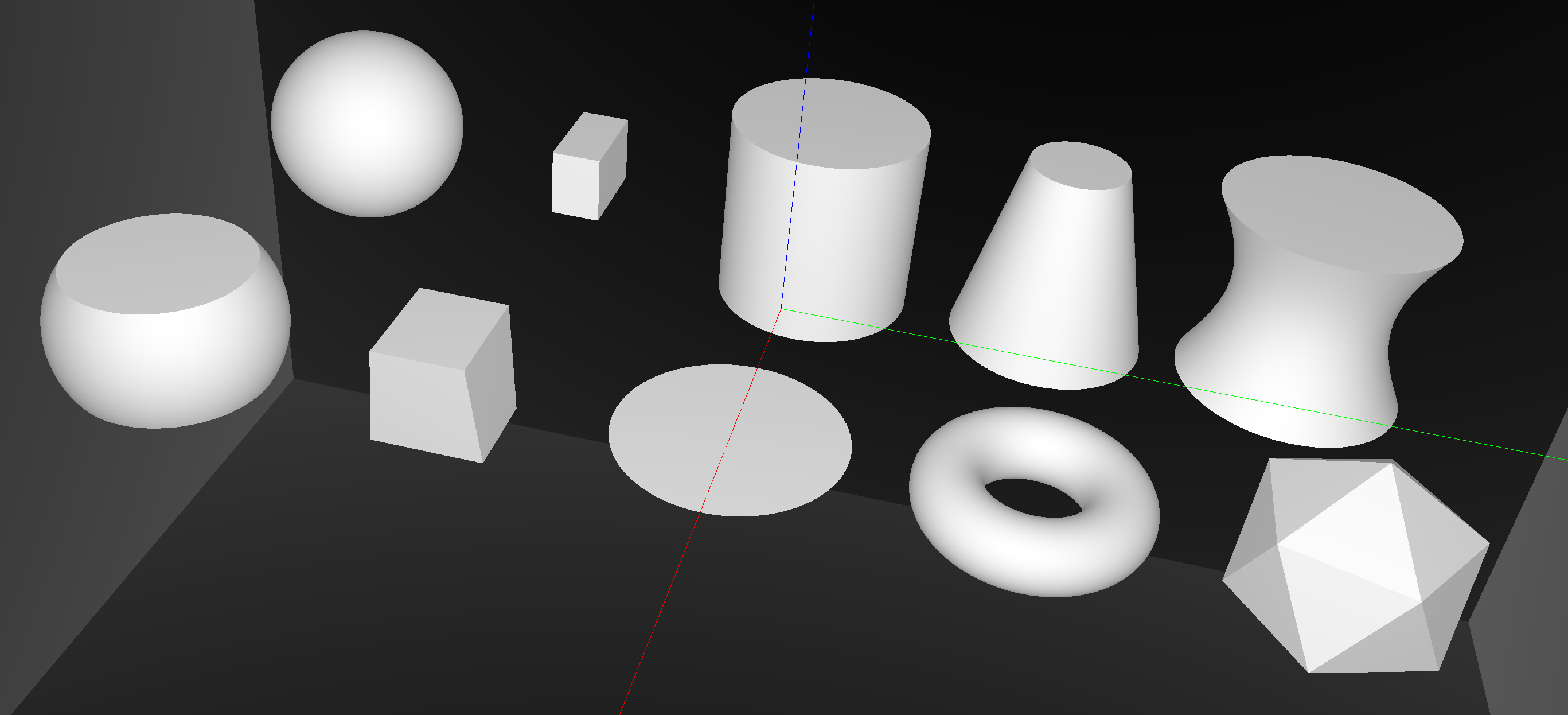
- polynomial roots in t -> intersection positions + surface normals, calculated for every raytrace pixel
- same intersect calculation used for raytracing and photon propagation
- full detector geometries composed from CSG boolean combinations of primitive solids
Torus : much more difficult/expensive than other primitives
Torus artifacts


3D parametric ray : ray(x,y,z;t) = rayOrigin + t * rayDirection
- ray-torus intersection -> solve quartic polynomial in t
- A t^4 + B t^3 + C t^2 + D t + E = 0
High order equation
- very large difference between coefficients
- varying ray -> wide range of very coefficients
- numerically problematic, requires double precision
- several mathematical approaches used, work in progress
Best Solution : replace torus
- eg model PMT neck with hyperboloid, not cylinder-torus
Opticks Analytic Daya Bay Near Site, GPU Raytrace (3)
Opticks Analytic Daya Bay Near Site, GPU Raytrace (1)
Opticks Analytic Daya Bay Near Site, GPU Raytrace (0)
Opticks Analytic Daya Bay Near Site, GPU Raytrace (2)
Opticks Analytic JUNO Chimney, GPU Raytrace (0)
Opticks Analytic JUNO PMT Snap, GPU Raytrace (1)
Constructive Solid Geometry (CSG) : Shapes defined "by construction"
CSG Binary Tree
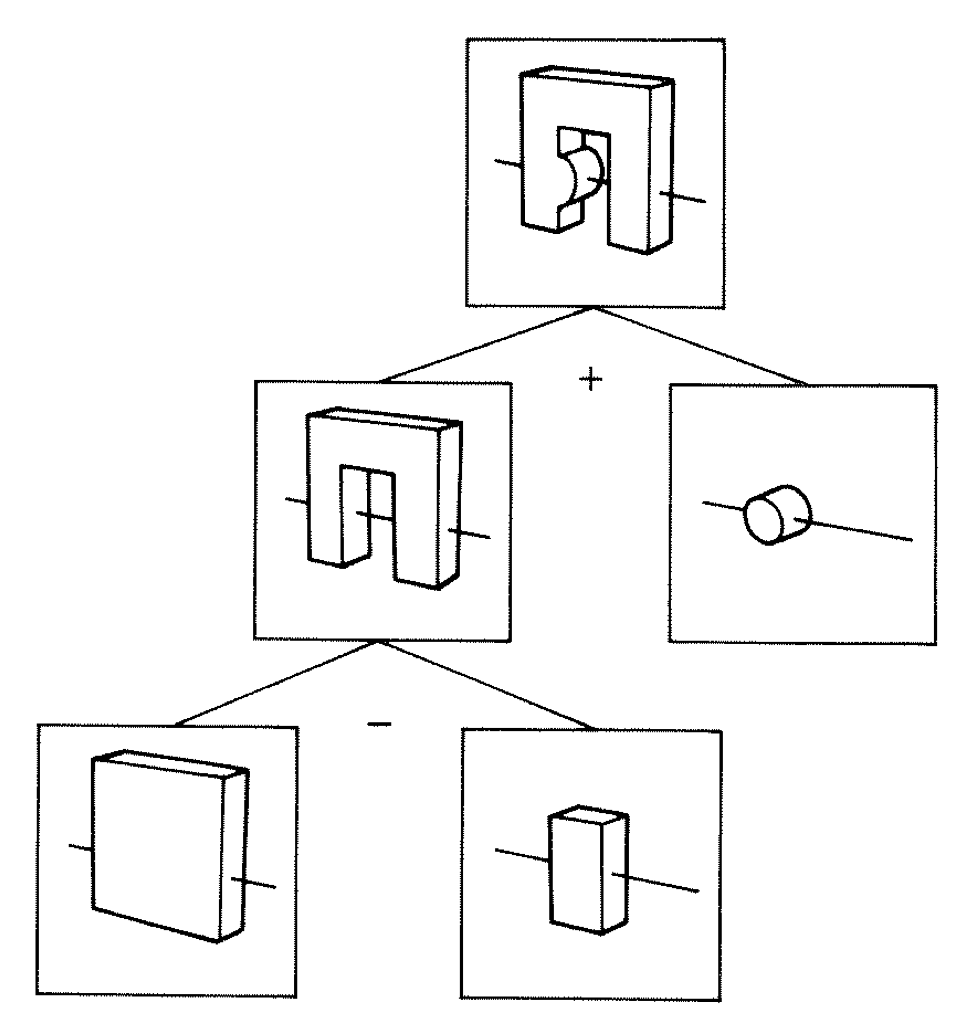
Primitives combined via binary operators
Simple by construction definition, implicit geometry.
- A, B implicit primitive solids
- A + B : union (OR)
- A * B : intersection (AND)
- A - B : difference (AND NOT)
- !B : complement (NOT) (inside <-> outside)
CSG expressions
- non-unique: A - B == A * !B
- represented by binary tree, primitives at leaves
3D Parametric Ray : ray(t) = r0 + t rDir
Ray Geometry Intersection
- primitive : find t roots of implicit eqn
- composite : pick primitive intersect, depending on CSG tree
How to pick exactly ?
CSG : Which primitive intersect to pick ?
In/On/Out transitions
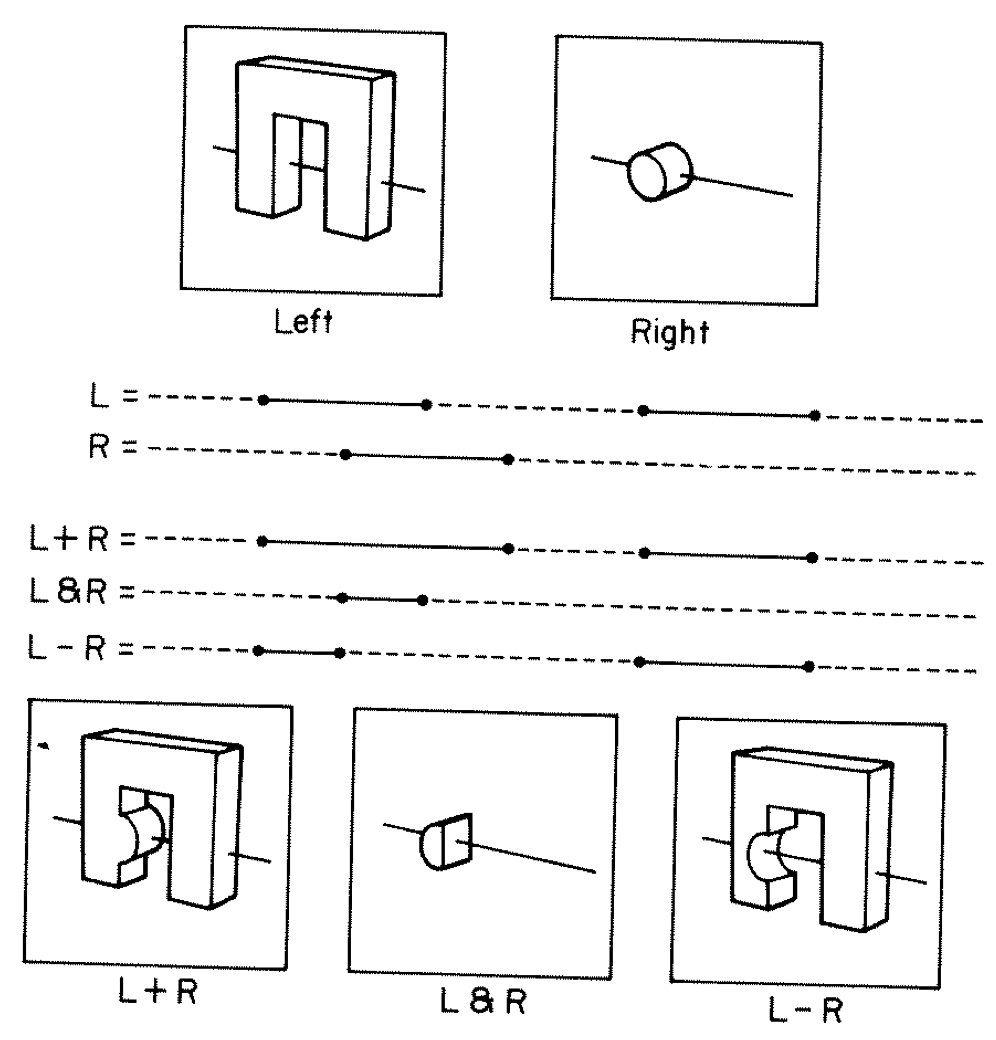
Classical Roth diagram approach
- find all ray/primitive intersects
- recursively combine inside intervals using CSG operator
- works from leaves upwards
Computational requirements:
- find all intersects, store them, order them
- recursive traverse
BUT : High performance on GPU requires:
- massive parallelism -> more the merrier
- low register usage -> keep it simple
- small stack size -> avoid recursion
Classical approach not appropriate on GPU
Ray Tracing CSG Objects Using Single Hit Intersections (A. Kensler) [*]
Outside/Inside Unions
dot(normal,rayDir) -> Enter/Exit
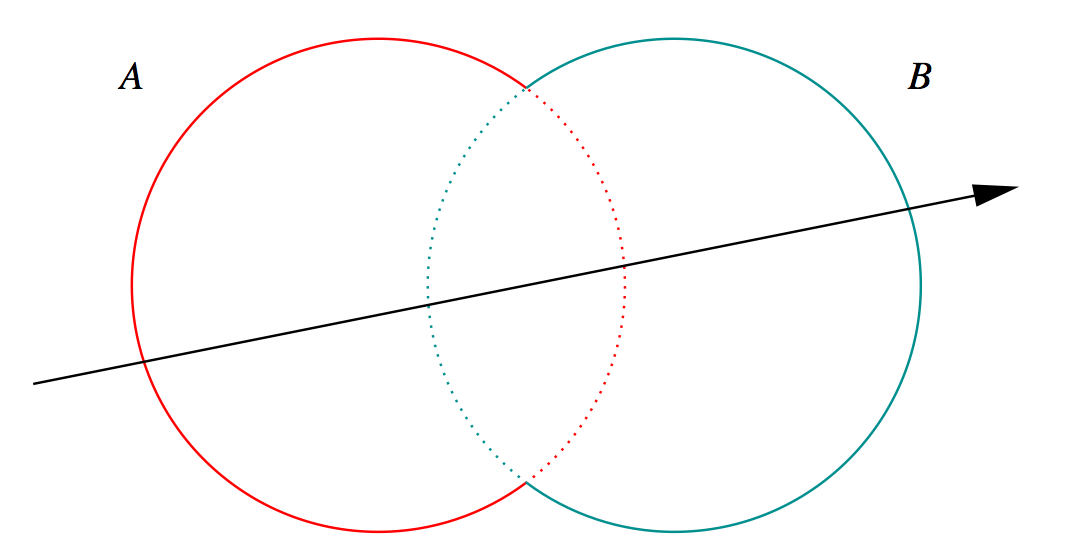

- A + B boundary not inside other
- A * B boundary inside other
- Classify A,B intersects, Enter/Exit/Miss
- state(A,B) -> action
- LoopA : tMinA->tA, re-intersectA, re-classifyA (ditto LoopB)
| Union, tA < tB | Enter B | Exit B | Miss B |
|---|---|---|---|
| Enter A | ReturnA | LoopA | ReturnA |
| Exit A | ReturnA | ReturnB | ReturnA |
| Miss A | ReturnB | ReturnB | ReturnMiss |
| Union, tB < tA | Enter B | Exit B | Miss B |
|---|---|---|---|
| Enter A | ReturnB | ReturnB | ReturnA |
| Exit A | LoopB | ReturnA | ReturnA |
| Miss A | ReturnB | ReturnB | ReturnMiss |
Recursive CSG tree python prototype of Kensler pseudocode worked after state table corrections/extensions
- BUT GPU/OptiX demands: no recursion in intersect program
- [*] Ray Tracing CSG Objects Using Single Hit Intersections, Andrew Kensler (2006)
- with corrections by author of XRT Raytracer http://xrt.wikidot.com/doc:csg
CSG Complete Binary Tree Serialization -> simplifies GPU side
Bit Twiddling Navigation
- parent(i) = i/2 = i >> 1
- leftchild(i) = 2*i = i << 1
- rightchild(i) = 2*i + 1 = (i << 1) + 1
- leftmost(height) = 1 << height
CSG Tree, leaf node primitives, internal node operators, 4x4 transforms on any node, serialized as complete binary tree:
- bit twiddling navigation avoids recursion
- no need to deserialize
- no child/parent pointers
- BUT: very inefficient when unbalanced
Height 3 complete binary tree with level order indices:
depth elevation
1 0 3
10 11 1 2
100 101 110 111 2 1
1000 1001 1010 1011 1100 1101 1110 1111 3 0
postorder_next(i,elevation) = i & 1 ? i >> 1 : (i << elevation) + (1 << elevation) ; // from pattern of bits
Postorder tree traverse visits all nodes, starting from leftmost, such that children are visited prior to their parents.
Evaluative CSG intersection Pseudocode : recursion emulated
fullTree = PACK( 1 << height, 1 >> 1 ) // leftmost, parent_of_root(=0) tranche.push(fullTree, ray.tmin) while (!tranche.empty) // stack of begin/end indices { begin, end, tmin <- tranche.pop ; node <- begin ; while( node != end ) // over tranche of postorder traversal { elevation = height - TREE_DEPTH(node) ; if(is_primitive(node)){ isect <- intersect_primitive(node, tmin) ; csg.push(isect) } else{ i_left, i_right = csg.pop, csg.pop // csg stack of intersect normals, t l_state = CLASSIFY(i_left, ray.direction, tmin) r_state = CLASSIFY(i_right, ray.direction, tmin) action = LUT(operator(node), leftIsCloser)(l_state, r_state) if( action is ReturnLeft/Right) csg.push(i_left or i_right) else if( action is LoopLeft/Right) { left = 2*node ; right = 2*node + 1 ; endTranche = PACK( node, end ); leftTranche = PACK( left << (elevation-1), right << (elevation-1) ) rightTranche = PACK( right << (elevation-1), node ) loopTranche = action ? leftTranche : rightTranche tranche.push(endTranche, tmin) tranche.push(loopTranche, tminAdvanced ) // subtree re-traversal with changed tmin break ; // to next tranche } } node <- postorder_next(node, elevation) // bit twiddling postorder } } isect = csg.pop(); // winning intersect
https://bitbucket.org/simoncblyth/opticks/src/tip/optixrap/cu/csg_intersect_boolean.h
Large Geometry Techniques : Instancing Mandatory
Geometry analysed to find instances
JUNO: ~90M --> 0.1M triangles
- 18k 20" PMTs
- 36k 3" PMTs
OpenGL instanced rendering
- drastic reduction in GPU memory
- one set of vertices for each PMT type
- 4x4 matrices position each PMT
Optimizations
- cull non-visible instances
- level of detail (LOD) meshes
- full/simplified/bbox
- switch mesh based on distance to PMT
GPU Instance Culling with Level Of Detail
Idealized geometry tests : photon generation, propagation, reemission
Match achieved after many fixes
- scattering, was comparing different implementations
- diffuse reflection, ported G4 approach
- reemission "rejoining"
- missing optical surfaces
- truncation recording discrepancy
- group velocity of wrong material after refraction (G4 issue 1275)
- interpolation mismatches
Work guided by the next largest chi2 contributor
Idealized "tconcentric" scintillator detector avoids any geometry issues, tests optical physics in isolation
Single executable (cfg4 package):
- performs both pure G4 and hybrid G4+Opticks simulations
- writes two events recording up to 16 steps of each photon
- photons indexed on GPU by history and material sequences
- history category counts comparison, Opticks/G4 chi2/df ~ 1.0
- position, time, polarization, wavelength recorded at each step
point-by-point chi2-distance comparisons of 8 photon properties for top 100 history categories
tconcentric : spherical GdLS/LS/MineralOil
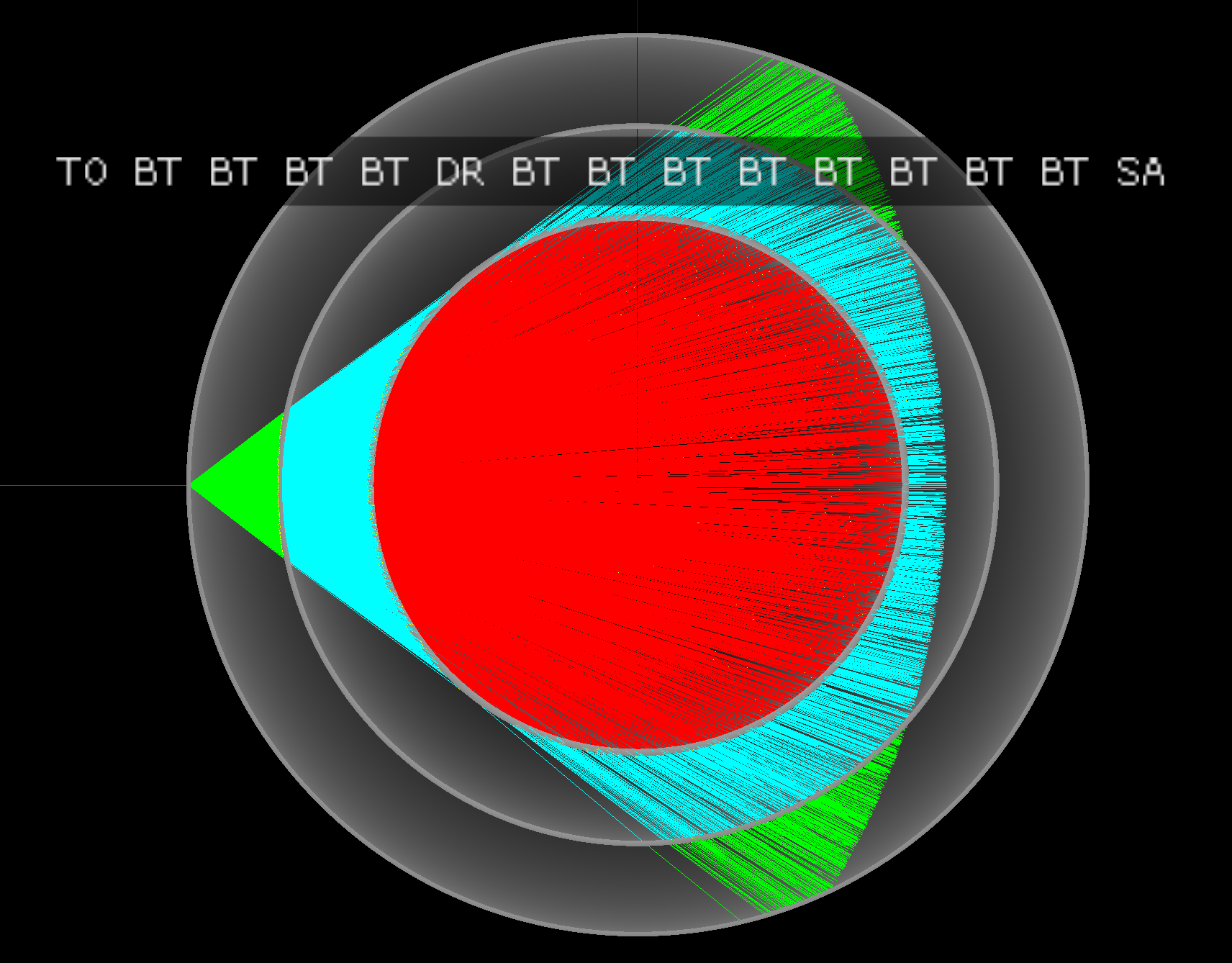
tconcentric : Opticks/Geant4 chi2 comparison
. seqhis_ana 1:concentric -1:concentric c2 . 1000000 1000000 373.13/356 = 1.05 (pval:0.256 prob:0.744) 0000 8ccccd 669843 670001 0.02 [6 ] TO BT BT BT BT SA 0001 4d 83950 84149 0.24 [2 ] TO AB 0002 8cccc6d 45490 44770 5.74 [7 ] TO SC BT BT BT BT SA 0003 4ccccd 28955 28718 0.97 [6 ] TO BT BT BT BT AB 0004 4ccd 23187 23170 0.01 [4 ] TO BT BT AB 0005 8cccc5d 20238 20140 0.24 [7 ] TO RE BT BT BT BT SA 0006 8cc6ccd 10214 10357 0.99 [7 ] TO BT BT SC BT BT SA 0007 86ccccd 10176 10318 0.98 [7 ] TO BT BT BT BT SC SA 0008 89ccccd 7540 7710 1.90 [7 ] TO BT BT BT BT DR SA 0009 8cccc55d 5976 5934 0.15 [8 ] TO RE RE BT BT BT BT SA 0010 45d 5779 5766 0.01 [3 ] TO RE AB 0011 8cccccccc9ccccd 5339 5269 0.46 [15] TO BT BT BT BT DR BT BT BT BT BT BT BT BT SA 0012 8cc5ccd 5111 4940 2.91 [7 ] TO BT BT RE BT BT SA 0013 46d 4797 4886 0.82 [3 ] TO SC AB 0014 8cccc9ccccd 4494 4469 0.07 [11] TO BT BT BT BT DR BT BT BT BT SA 0015 8cccccc6ccd 3317 3302 0.03 [11] TO BT BT SC BT BT BT BT BT BT SA 0016 8cccc66d 2670 2675 0.00 [8 ] TO SC SC BT BT BT BT SA 0017 49ccccd 2432 2383 0.50 [7 ] TO BT BT BT BT DR AB 0018 4cccc6d 2043 1991 0.67 [7 ] TO SC BT BT BT BT AB 0019 4cc6d 1755 1826 1.41 [5 ] TO SC BT BT AB
Top 20 chart above, (category 100 down to ~100 photons for propagation of 1M photons)
tconcentric : Opticks/Geant4 distrib chi2/df ~ 1.0
- Top 100 history categories correspond to ~900 propagation points
- 8 quantities at each point : ~7200 histograms pairs to chi2 compare
- selecting discrepant points : distchi2 > 1.1 (yields 41 out of 900 points)
XYZT:position/time ABCW:polarization/wavelength
| iv | is | na | nb | reclab | X | Y | Z | T | A | B | C | W | seqc2 | distc2 |
|---|---|---|---|---|---|---|---|---|---|---|---|---|---|---|
| 26 | 5 | 20238 | 20140 | TO [RE] BT BT BT BT SA | 0.85 | 0.00 | 0.00 | 1.31 | 1.12 | 1.37 | 1.10 | 0.78 | 0.24 | 1.10 |
| 27 | 5 | 20238 | 20140 | TO RE [BT] BT BT BT SA | 2.14 | 2.26 | 0.80 | 1.08 | 1.15 | 0.82 | 0.76 | 0.78 | 0.24 | 1.18 |
| 28 | 5 | 20238 | 20140 | TO RE BT [BT] BT BT SA | 2.01 | 2.23 | 0.79 | 0.83 | 1.17 | 0.83 | 0.83 | 0.78 | 0.24 | 1.17 |
| 29 | 5 | 20238 | 20140 | TO RE BT BT [BT] BT SA | 2.66 | 4.37 | 1.13 | 0.49 | 1.20 | 0.81 | 0.79 | 0.78 | 0.24 | 1.68 |
| 30 | 5 | 20238 | 20140 | TO RE BT BT BT [BT] SA | 2.56 | 4.48 | 1.19 | 1.04 | 1.12 | 0.97 | 0.91 | 0.78 | 0.24 | 1.75 |
| 31 | 5 | 20238 | 20140 | TO RE BT BT BT BT [SA] | 3.18 | 5.17 | 1.23 | 0.48 | 1.12 | 0.97 | 0.91 | 0.78 | 0.24 | 2.06 |
| 38 | 6 | 10214 | 10357 | TO BT BT SC BT BT [SA] | 0.79 | 1.37 | 1.43 | 0.55 | 1.00 | 1.33 | 0.97 | 0.00 | 0.99 | 1.16 |
| 52 | 8 | 7540 | 7710 | TO BT BT BT BT DR [SA] | 1.70 | 1.32 | 1.48 | 1.49 | 1.12 | 1.03 | 1.37 | 0.00 | 1.90 | 1.28 |
| 56 | 9 | 5976 | 5934 | TO RE RE [BT] BT BT BT SA | 1.26 | 1.51 | 1.21 | 2.36 | 0.99 | 1.40 | 1.10 | 1.65 | 0.15 | 1.24 |
| 57 | 9 | 5976 | 5934 | TO RE RE BT [BT] BT BT SA | 1.23 | 1.39 | 1.25 | 2.31 | 0.98 | 1.45 | 0.98 | 1.65 | 0.15 | 1.21 |
| 58 | 9 | 5976 | 5934 | TO RE RE BT BT [BT] BT SA | 1.24 | 0.98 | 1.18 | 1.88 | 0.97 | 1.39 | 1.01 | 1.65 | 0.15 | 1.14 |
| 59 | 9 | 5976 | 5934 | TO RE RE BT BT BT [BT] SA | 1.24 | 0.90 | 1.04 | 1.83 | 0.93 | 1.55 | 0.92 | 1.65 | 0.15 | 1.11 |
| 60 | 9 | 5976 | 5934 | TO RE RE BT BT BT BT [SA] | 0.95 | 1.03 | 1.50 | 3.12 | 0.93 | 1.55 | 0.92 | 1.65 | 0.15 | 1.18 |
| 69 | 11 | 5339 | 5269 | TO BT BT BT BT [DR] BT BT BT BT BT BT BT BT SA | 0.00 | 0.00 | 0.00 | 0.00 | 1.29 | 1.69 | 2.42 | 0.00 | 0.46 | 1.31 |
| 74 | 11 | 5339 | 5269 | TO BT BT BT BT DR BT BT BT BT [BT] BT BT BT SA | 1.10 | 1.45 | 1.02 | 0.67 | 1.42 | 0.83 | 1.38 | 0.00 | 0.46 | 1.12 |
| 75 | 11 | 5339 | 5269 | TO BT BT BT BT DR BT BT BT BT BT [BT] BT BT SA | 0.98 | 1.42 | 1.16 | 0.52 | 1.58 | 0.82 | 1.46 | 0.00 | 0.46 | 1.15 |
| 76 | 11 | 5339 | 5269 | TO BT BT BT BT DR BT BT BT BT BT BT [BT] BT SA | 1.46 | 1.66 | 0.79 | 0.65 | 1.69 | 0.89 | 1.46 | 0.00 | 0.46 | 1.21 |
| 77 | 11 | 5339 | 5269 | TO BT BT BT BT DR BT BT BT BT BT BT BT [BT] SA | 1.04 | 1.64 | 0.81 | 0.51 | 2.20 | 0.91 | 1.35 | 0.00 | 0.46 | 1.19 |
| 78 | 11 | 5339 | 5269 | TO BT BT BT BT DR BT BT BT BT BT BT BT BT [SA] | 1.10 | 1.56 | 0.73 | 0.21 | 2.20 | 0.91 | 1.35 | 0.00 | 0.46 | 1.17 |
| 85 | 12 | 5111 | 4940 | TO BT BT RE BT BT [SA] | 1.26 | 2.13 | 0.79 | 2.07 | 1.03 | 0.93 | 0.72 | 0.68 | 2.91 | 1.11 |
| 94 | 14 | 4494 | 4469 | TO BT BT BT BT [DR] BT BT BT BT SA | 0.00 | 0.00 | 0.00 | 0.00 | 1.90 | 3.74 | 1.95 | 0.00 | 0.07 | 2.01 |
| 95 | 14 | 4494 | 4469 | TO BT BT BT BT DR [BT] BT BT BT SA | 3.85 | 1.83 | 0.90 | 0.82 | 2.20 | 1.45 | 1.11 | 0.00 | 0.07 | 1.41 |
| 96 | 14 | 4494 | 4469 | TO BT BT BT BT DR BT [BT] BT BT SA | 1.94 | 1.82 | 1.07 | 0.85 | 2.67 | 1.30 | 1.08 | 0.00 | 0.07 | 1.39 |
| 97 | 14 | 4494 | 4469 | TO BT BT BT BT DR BT BT [BT] BT SA | 1.61 | 1.35 | 1.48 | 0.31 | 2.00 | 1.22 | 1.28 | 0.00 | 0.07 | 1.35 |
| 98 | 14 | 4494 | 4469 | TO BT BT BT BT DR BT BT BT [BT] SA | 1.96 | 1.31 | 1.39 | 0.66 | 2.13 | 1.03 | 1.42 | 0.00 | 0.07 | 1.36 |
| 99 | 14 | 4494 | 4469 | TO BT BT BT BT DR BT BT BT BT [SA] | 2.29 | 0.91 | 1.05 | 4.14 | 2.13 | 1.03 | 1.42 | 0.00 | 0.07 | 1.23 |
| 104 | 15 | 3317 | 3302 | TO BT BT SC [BT] BT BT BT BT BT SA | 0.60 | 1.02 | 1.75 | 1.92 | 0.77 | 1.23 | 1.39 | 0.00 | 0.03 | 1.20 |
| 105 | 15 | 3317 | 3302 | TO BT BT SC BT [BT] BT BT BT BT SA | 0.77 | 1.35 | 1.34 | 1.98 | 0.73 | 1.13 | 1.41 | 0.00 | 0.03 | 1.17 |
| 108 | 15 | 3317 | 3302 | TO BT BT SC BT BT BT BT [BT] BT SA | 1.48 | 1.01 | 1.73 | 0.51 | 0.85 | 1.00 | 1.05 | 0.00 | 0.03 | 1.15 |
| 124 | 17 | 2432 | 2383 | TO BT BT BT BT [DR] AB | 0.00 | 0.00 | 0.00 | 0.00 | 1.64 | 0.92 | 0.71 | 0.00 | 0.50 | 1.20 |
| 140 | 20 | 1815 | 1805 | TO RE [RE] RE BT BT BT BT SA | 1.80 | 0.56 | 1.73 | 0.59 | 1.31 | 1.20 | 1.42 | 0.60 | 0.03 | 1.26 |
| 141 | 20 | 1815 | 1805 | TO RE RE [RE] BT BT BT BT SA | 1.30 | 1.02 | 2.24 | 1.02 | 1.09 | 1.06 | 1.17 | 1.07 | 0.03 | 1.15 |
| 144 | 20 | 1815 | 1805 | TO RE RE RE BT BT [BT] BT SA | 1.05 | 1.32 | 1.03 | 0.53 | 0.93 | 1.31 | 1.12 | 1.07 | 0.03 | 1.10 |
| 222 | 29 | 1105 | 1168 | TO BT BT RE BT BT [BT] BT BT BT SA | 2.42 | 2.53 | 2.26 | 2.49 | 1.29 | 1.25 | 0.65 | 1.08 | 1.75 | 1.65 |
| 223 | 29 | 1105 | 1168 | TO BT BT RE BT BT BT [BT] BT BT SA | 2.32 | 2.44 | 1.98 | 2.38 | 1.03 | 1.07 | 0.72 | 1.08 | 1.75 | 1.53 |
| 224 | 29 | 1105 | 1168 | TO BT BT RE BT BT BT BT [BT] BT SA | 3.13 | 2.49 | 1.32 | 1.34 | 1.11 | 1.23 | 0.69 | 1.08 | 1.75 | 1.56 |
| 225 | 29 | 1105 | 1168 | TO BT BT RE BT BT BT BT BT [BT] SA | 2.83 | 2.44 | 1.36 | 1.06 | 0.92 | 1.08 | 0.69 | 1.08 | 1.75 | 1.47 |
| 226 | 29 | 1105 | 1168 | TO BT BT RE BT BT BT BT BT BT [SA] | 3.24 | 3.21 | 1.03 | 2.18 | 0.92 | 1.08 | 0.69 | 1.08 | 1.75 | 1.59 |
| 241 | 31 | 1067 | 1013 | TO BT BT BT BT DR [BT] BT AB | 1.25 | 1.53 | 0.80 | 0.27 | 2.03 | 0.90 | 1.40 | 0.00 | 1.40 | 1.27 |
| 242 | 31 | 1067 | 1013 | TO BT BT BT BT DR BT [BT] AB | 1.30 | 1.88 | 0.76 | 0.37 | 1.44 | 0.95 | 1.38 | 0.00 | 1.40 | 1.18 |
| 248 | 32 | 1036 | 988 | TO RE BT BT [AB] | 1.00 | 1.78 | 1.69 | 1.55 | 0.62 | 0.87 | 0.86 | 1.33 | 1.14 | 1.13 |
PMT Opticks/Geant4 step distribution comparison TO BT [SD]
Good agreement reached, after several fixes: geometry, total internal reflection, group velocity
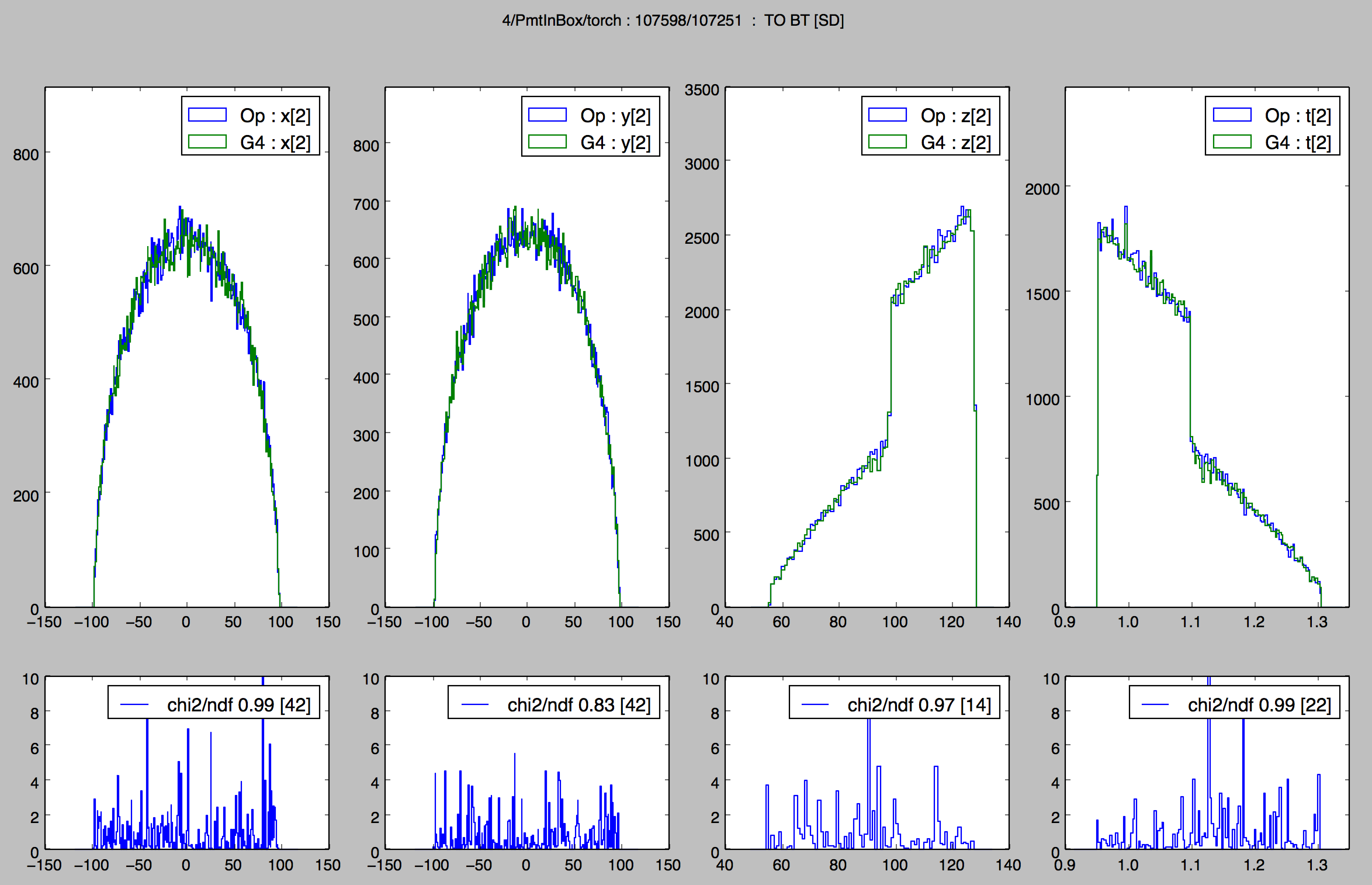
position(xyz), time(t)
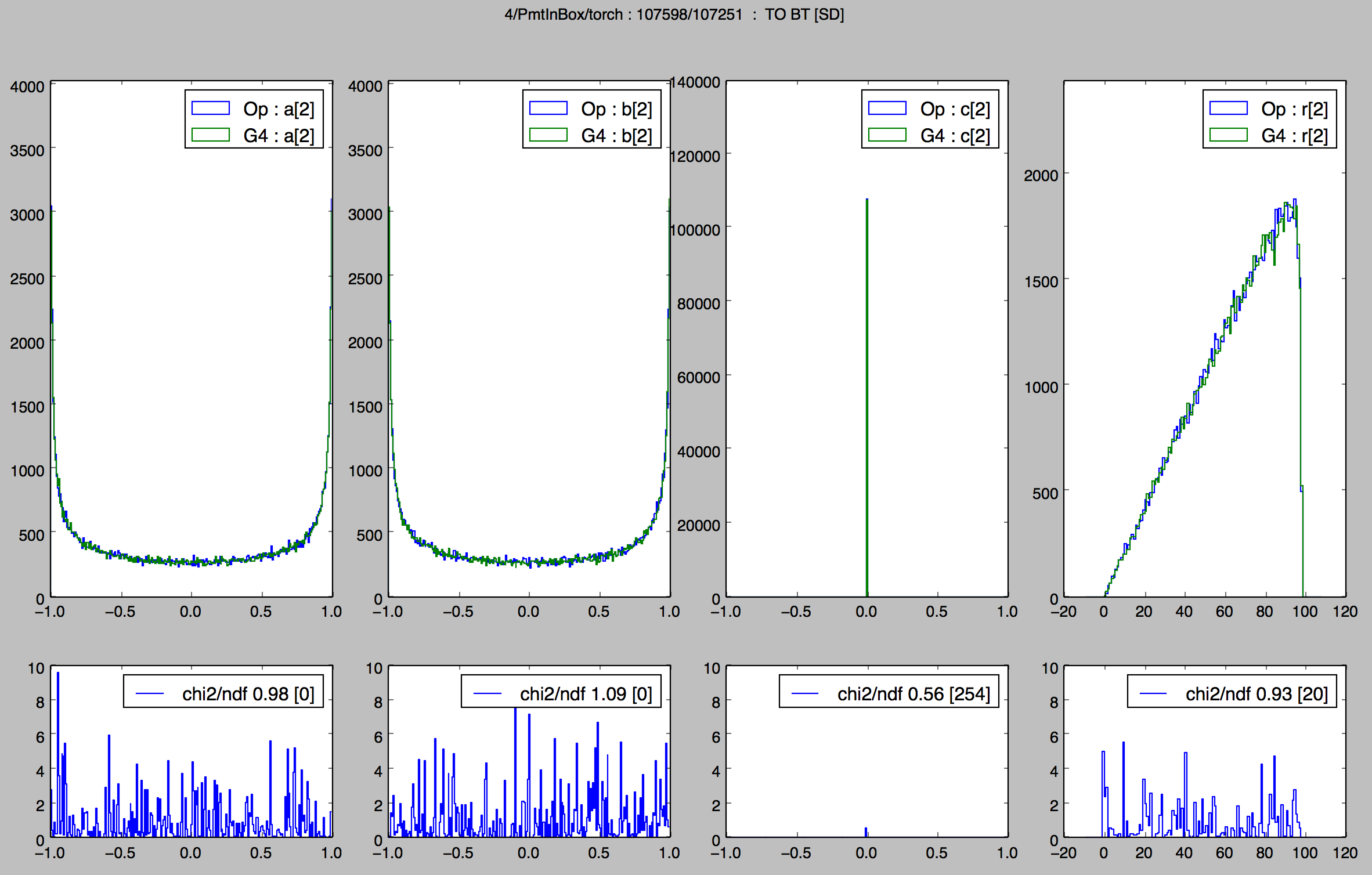
polarization(abc), radius(r)
PMT Opticks/Geant4 step distribution comparison : chi2/ndf
Consistent : chi2/ndf ~ 1
Very good Opticks/Geant4 agreement
- identical geometries
- identical optical physics
XYTZ: position, time ABCR: polarization, radius
| 4/PMT In Box/torch : | X | Y | Z | T | A | B | C | R |
|---|---|---|---|---|---|---|---|---|
| 340271/340273 : [TO] BT SA | 1.15 | 1.00 | 0.00 | 0.00 | 1.06 | 1.03 | 0.00 | 1.21 |
| 340271/340273 : TO [BT] SA | 1.15 | 1.00 | 1.06 | 0.91 | 1.06 | 1.03 | 0.00 | 1.21 |
| 340271/340273 : TO BT [SA] | 0.97 | 1.02 | 1.05 | 0.99 | 1.06 | 1.03 | 0.00 | 1.29 |
| 107598/107251 : [TO] BT SD | 0.91 | 0.73 | 0.56 | 0.56 | 0.98 | 1.09 | 0.56 | 0.94 |
| 107598/107251 : TO [BT] SD | 0.91 | 0.73 | 0.81 | 0.93 | 0.98 | 1.09 | 0.56 | 0.94 |
| 107598/107251 : TO BT [SD] | 0.99 | 0.83 | 0.97 | 0.99 | 0.98 | 1.09 | 0.56 | 0.93 |
| 23217/23260 : [TO] BT BT SA | 0.94 | 0.82 | 0.04 | 0.04 | 0.97 | 0.89 | 0.04 | 0.57 |
| 23217/23260 : TO [BT] BT SA | 0.94 | 0.82 | 0.70 | 0.50 | 0.97 | 0.89 | 0.04 | 0.57 |
| 23217/23260 : TO BT [BT] SA | 0.91 | 0.94 | 0.43 | 0.60 | 0.97 | 0.89 | 0.04 | 0.05 |
| 23217/23260 : TO BT BT [SA] | 0.94 | 0.88 | 0.04 | 0.35 | 0.97 | 0.89 | 0.04 | 0.72 |
| 18866/19048 : [TO] AB | 0.99 | 1.10 | 0.87 | 0.87 | 0.85 | 0.84 | 0.87 | 1.00 |
| 18866/19048 : TO [AB] | 0.99 | 1.10 | 0.93 | 0.92 | 0.85 | 0.84 | 0.87 | 1.00 |
| 3179/3133 : [TO] SC SA | 1.07 | 0.83 | 0.34 | 0.34 | 0.86 | 0.96 | 0.34 | 0.73 |
| 3179/3133 : TO [SC] SA | 1.07 | 0.83 | 0.98 | 1.05 | 0.98 | 1.06 | 0.98 | 0.73 |
| 3179/3133 : TO SC [SA] | 0.96 | 1.04 | 0.93 | 0.97 | 0.98 | 1.06 | 0.98 | 1.10 |
| 2204/2249 : [TO] BT AB | 0.85 | 1.04 | 0.45 | 0.45 | 0.99 | 0.92 | 0.45 | 1.06 |
| 2204/2249 : TO [BT] AB | 0.85 | 1.04 | 0.95 | 0.88 | 0.99 | 0.92 | 0.45 | 1.06 |
| 2204/2249 : TO BT [AB] | 0.98 | 0.94 | 1.01 | 1.00 | 0.99 | 0.92 | 0.45 | 0.90 |
| 1696/1732 : [TO] BT BT AB | 1.05 | 0.85 | 0.38 | 0.38 | 0.86 | 1.09 | 0.38 | 0.26 |
| 1696/1732 : TO [BT] BT AB | 1.05 | 0.85 | 1.48 | 1.28 | 0.86 | 1.09 | 0.38 | 0.26 |
| 1696/1732 : TO BT [BT] AB | 0.99 | 0.86 | 1.17 | 1.40 | 0.86 | 1.09 | 0.38 | 0.86 |
| 1696/1732 : TO BT BT [AB] | 1.15 | 0.88 | 1.08 | 1.06 | 0.86 | 1.09 | 0.38 | 0.79 |
| 1446/1455 : [TO] BR SA | 1.21 | 0.94 | 0.03 | 0.03 | 0.90 | 0.87 | 0.03 | 1.09 |
| 1446/1455 : TO [BR] SA | 1.21 | 0.94 | 1.02 | 1.01 | 0.90 | 0.87 | 0.03 | 1.09 |
| 1446/1455 : TO BR [SA] | 1.00 | 0.93 | 0.97 | 0.99 | 0.90 | 0.87 | 0.03 | 1.04 |
Photon Propagation Times Geant4 cf Opticks
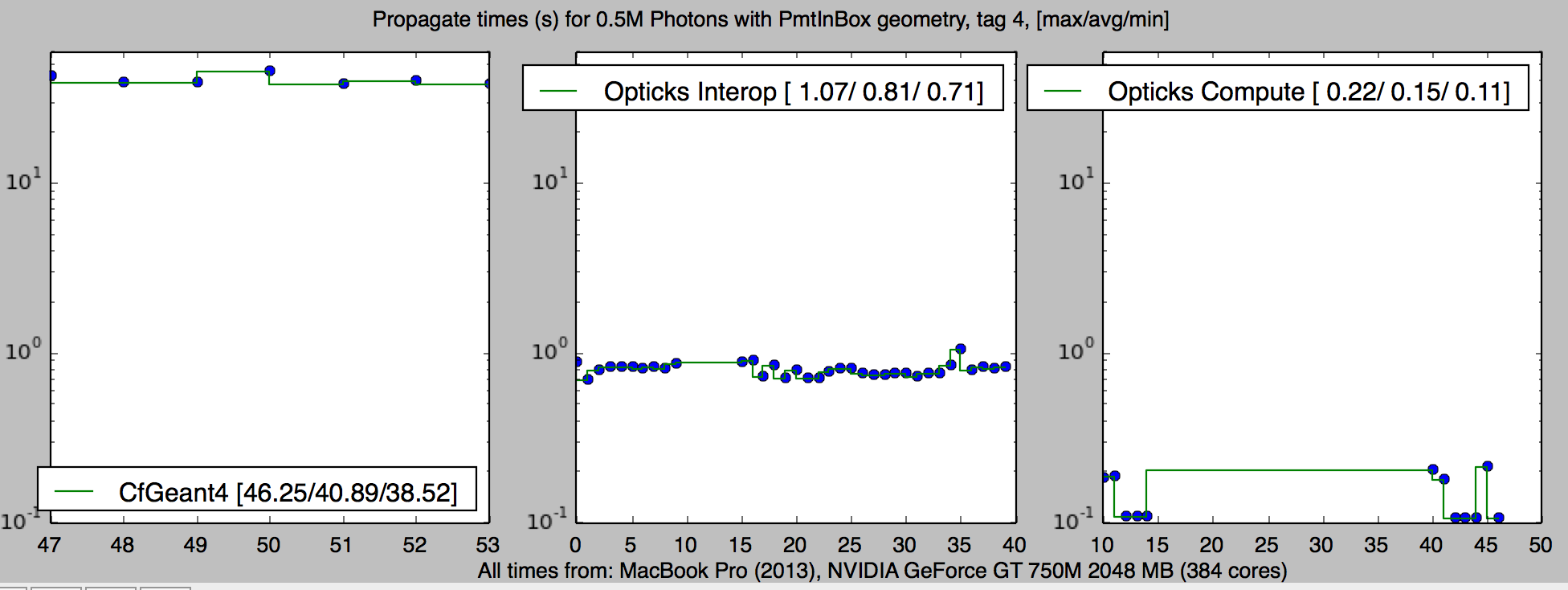
| Test | Geant4 10.2 | Opticks Interop | Opticks Compute |
|---|---|---|---|
| Rainbow 1M(S) | 56 s | 1.62 s | 0.28 s |
| Rainbow 1M(P) | 58 s | 1.71 s | 0.25 s |
| PmtInBox 0.5M | 41 s | 0.81 s | 0.15 s |
- Opticks > 200X Geant4 with only 384 core mobile GPU[1] (multi-GPU workstation up to 20x more cores)
- Interop uses OpenGL buffers allowing visualization, Compute uses OptiX buffers
- Interop/Compute : perfectly identical results, monitored by digest
[1] MacBook Pro (2013), NVIDIA GeForce GT 750M, 2048 MB, 384 cores
Summary
Overview
- Opticks 200x Geant4 with mobile GPU
- Expect: Opticks > 1000x Geant4 (with workstation GPUs)
- photon propagation time --> zero
- automated full fidelity translation of GDML

Opticks enables Geant4 based simulations to benefit from optical photon simulation taking effectively zero time and zero CPU memory, due to massive parallelism made accessible by NVIDIA OptiX. GDML detector geometry is auto translated into a GPU optimized analytic form, equivalent to the source geometry.

- The more photons the bigger the overall speedup (99% -> 100x)
- Drastic speedup -> better detector understanding -> greater precision
- Large PMT based neutrino experiments, such as JUNO, can benefit the most

Extras
OpticksDocs
Open Source Opticks
Documentation, install instructions. Repository.
- Mac, Linux, Windows (*)
- 16 C++ projects, ordered by dependency
- ~200 "Unit" Tests (CMake/CTest)
- 12 integration tests: tpmt, trainbow, tprism, treflect, tlens, tnewton, tg4gun, ...
- NumPy/Python analysis/debugging scripts
Geometry/event data use NumPy serialization:
import numpy as np
a = np.load("photons.npy")
(*) Windows VS2015, non-CUDA only so far
Pushed to backup as too detailed or duplicated
Opticks CSG Primitives : Closed Solids, Consistent Normals
Closed Solid as: implementation requires otherside intersect, Rigidly attached normals
| Type code | Python name | C++ nnode sub-struct |
|---|---|---|
| CSG_BOX3,CSG_BOX | box3,box | nbox |
| CSG_SPHERE,CSG_ZSPHERE | sphere,zsphere | nsphere,nzsphere |
| CSG_CYLINDER,CSG_DISC | cylinder,disc | ncylinder,ndisc |
| CSG_CONE | cone | ncone |
| CSG_CONVEXPOLYHEDRON | convexpolyhedron | nconvexpolyhedron |
| CSG_TRAPEZOID,CSG_SEGMENT | trapezoid,segment | nconvexpolyhedron |
| CSG_TORUS | torus | ntorus |
| CSG_HYPERBOLOID | hyperboloid | nhyperboloid |
- zsphere, cone, cylinder, disc : truncated shapes closed by endcaps <-- NOT OPTIONAL
- disc : avoids endcap degeneracy with very thin cylinders
- convexpolyhedron : defined by a set of planes, used for trapezoid and segment
- segment : prism shape used for deltaphi intersection
- !complemented (inside<->outside) solids handled by special casing classification (cannot miss otherside).
Non-primitives, high level CSG definition avoids loadsa code
- ellipsoid : non-uniform scaling of sphere, polycone : union of cylinders and cones
- inner-radii : via subtraction, deltaphi-segment : via intersect with segment
Opticks CSG Primitives : What is included
OptiX Geometry
OptiX provides acceleration of geometrical intersection, not the intersection itself.
- parametric ray : p(t) = p0 + t rayDir
- implicit surface : f(p) = 0
Intersect finding next closest root:
- smallest t, with t > tmin
- surface normal at t
OptiX/CUDA functions providing:
- axis aligned bounding box (AABB)
- intersect ray position (parametric t), surface normal
C++/nnode sub-struct methods
- signed distance function (SDF)
- parametric surface generation
4x4 Transforms on any node (translation/rotation/scaling)
Intersect inverse-transformed ray with un-transformed primitive
- parametric-t same in both frames
- inverse transform transposed brings normal back to world frame
Supporting non-uniform scaling requires rayDir not be be normalized (or assumed to be normalized) by primitives.
Opticks CSG : Balancing Deep Trees Drastically Improves Performance
Positive form CSG Trees
Apply deMorgan pushing negations down tree
- A - B -> A * !B
- !(A*B) -> !A + !B
- !(A+B) -> !A * !B
- !(A - B) -> !(A*!B) -> !A + B
End with only UNION, INTERSECT operators, and some complemented leaves.
COMMUTATIVE -> easily rearranged
Intended for solids, not scenes (tree height <8, <256 nodes[*])
- unbalanced trees inefficiently handled as complete binary trees
- CSG trees non-unique, many expressions of same shape
Dayabay TopESRCutHols lvidx:57 (height:9 totnodes:1023)
di(di(di(di(di(di(di(di(di(cy,cy),cy),cy),cy),cy),cy),cy),cy),cy)
di
di cy
di cy
di cy
di cy
di cy
di cy
di cy
di cy
cy cy
Balanced Tree, height:4 totnodes:31
in(in(in(in(cy,!cy),in(!cy,!cy)),in(in(!cy,!cy),in(!cy,!cy))),!cy)
in
in !cy
in in
in in in in
cy !cy !cy !cy !cy !cy !cy !cy
[*] Algorithm has no inherent height limit, but use of complete binary tree imposes practical performance limitation
Dayabay ESR reflector : Deep CSG tree : disc with 9 holes
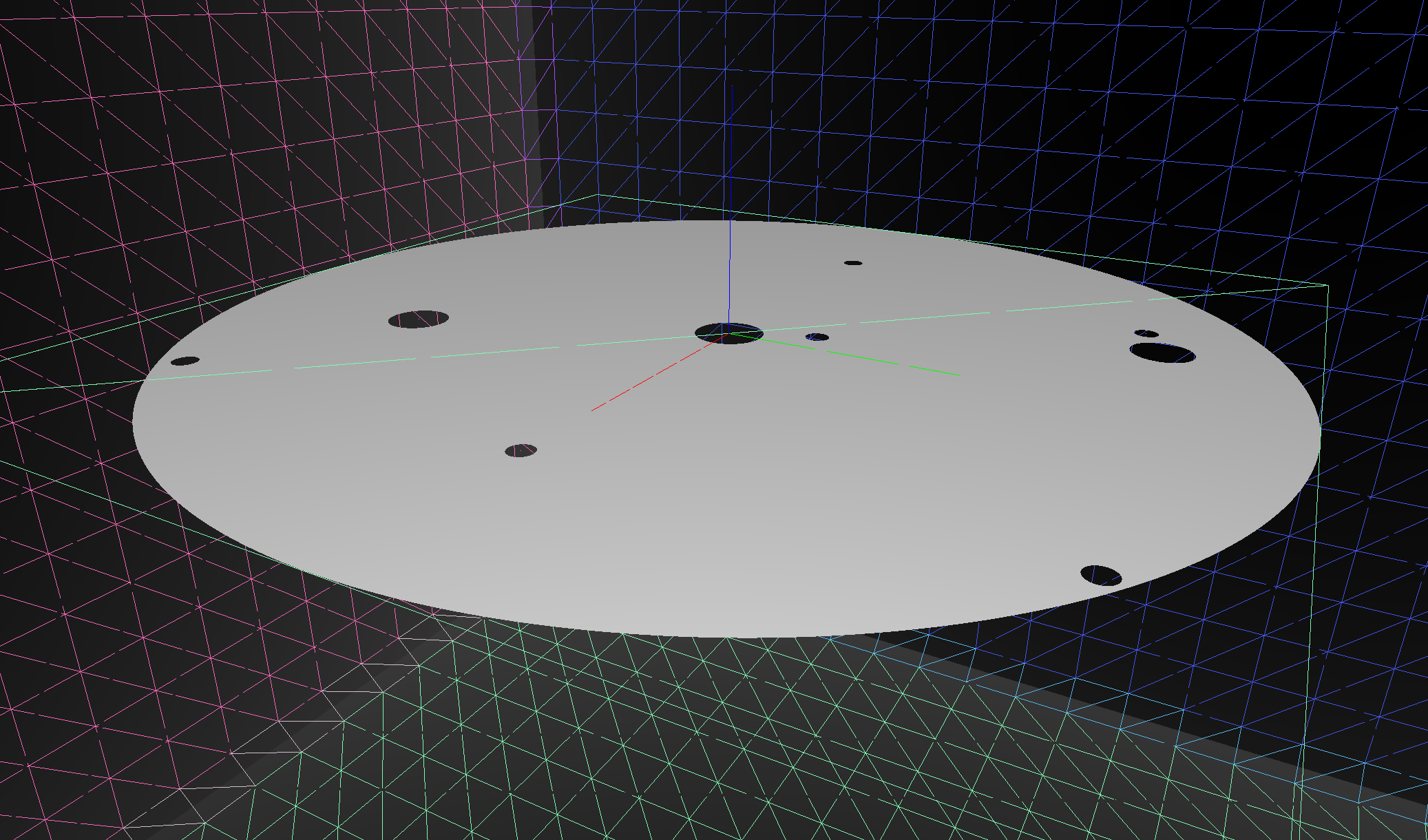
Geometry Modelling : Tesselated vs Analytic Photomultiplier Tubes
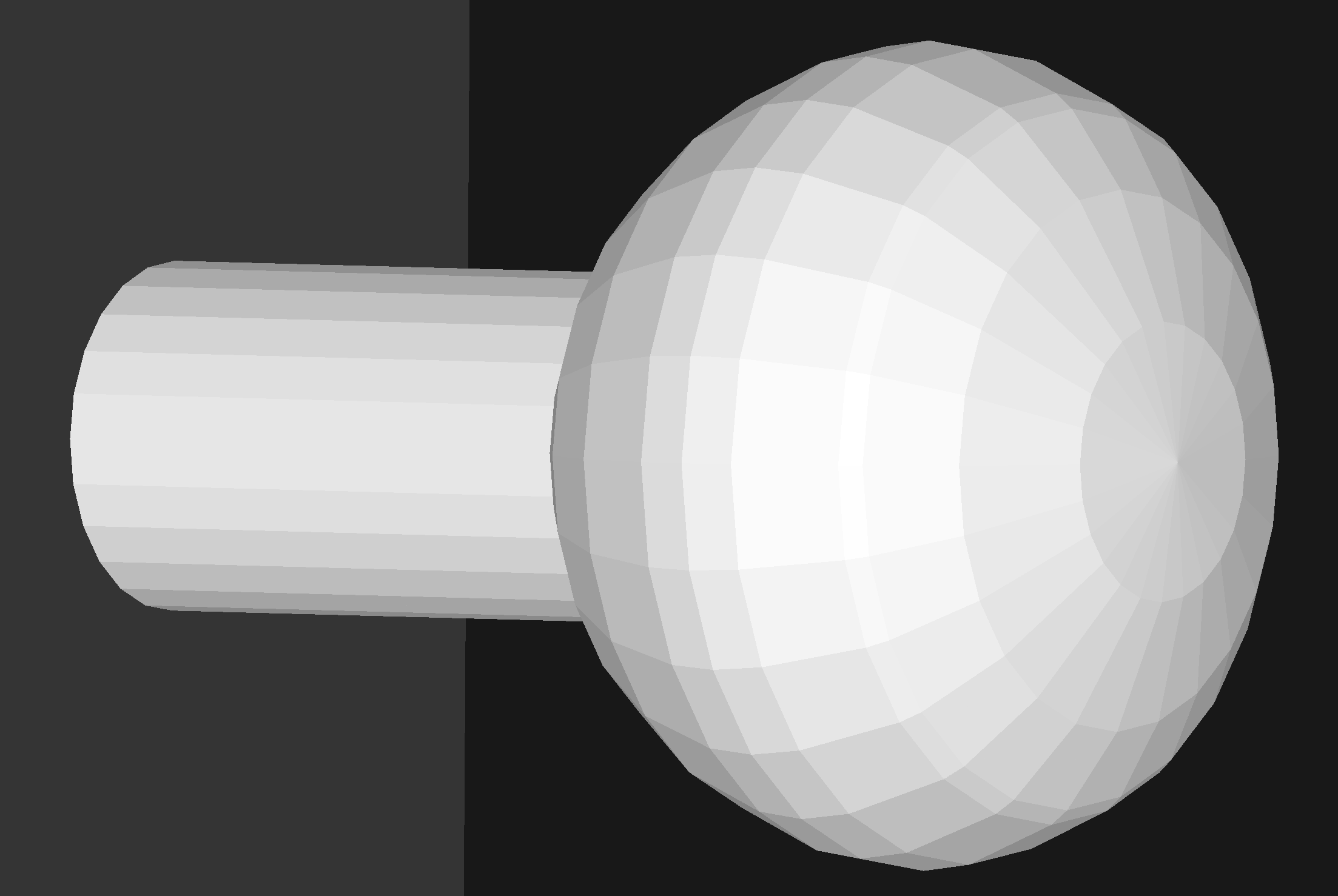
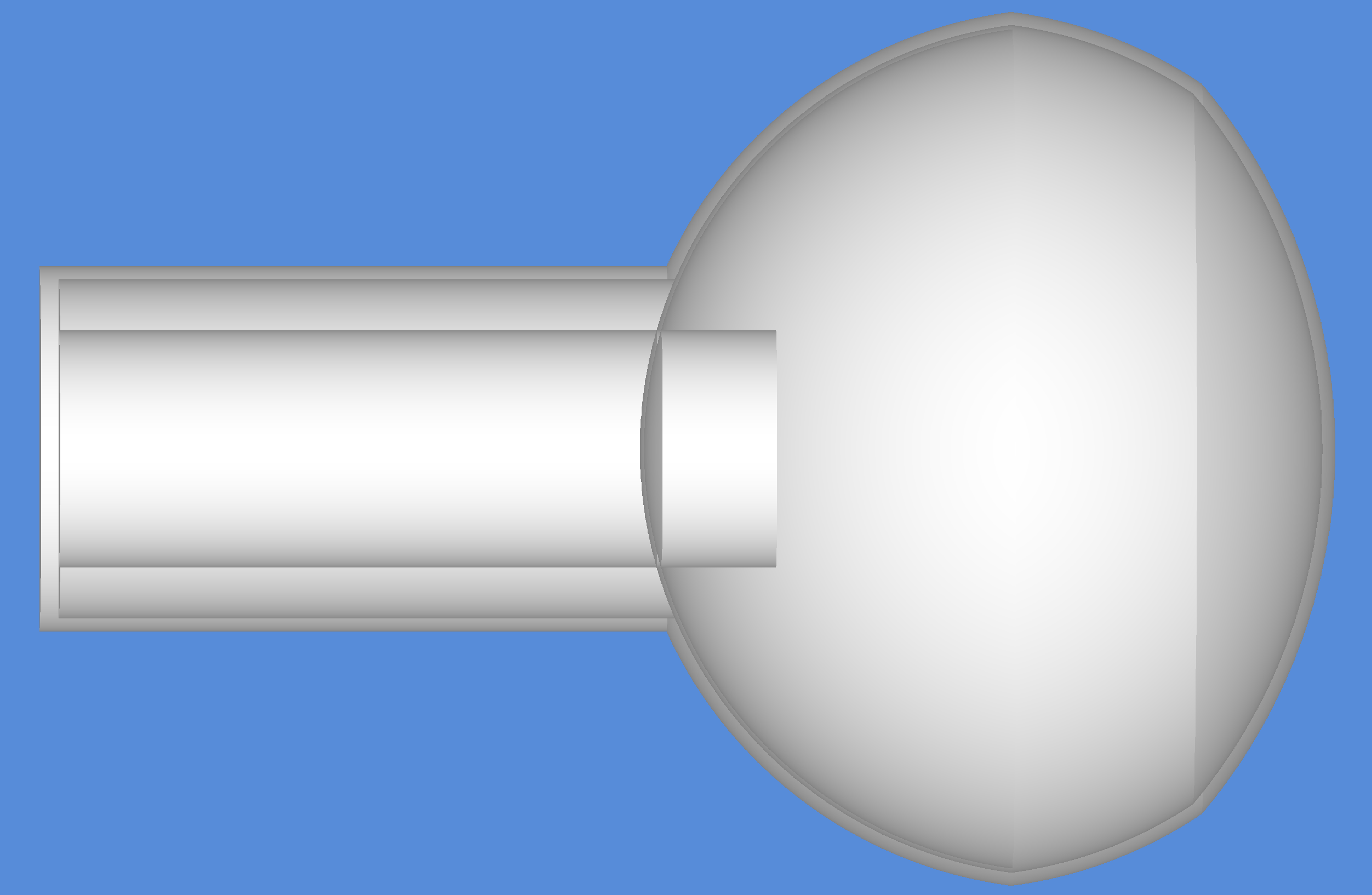

Analytic : more realistic, faster, less memory, much more effort
For Dayabay PMT:
- partition CSG solids into 12 single primitive parts (instead of 2928 triangles)
- splitting at geometrical intersections avoids implementing general CSG boolean handling
- geometry provided to OptiX in form of ray intersection and bounding box code
Aim : analytic description of geometry on critical optical path, remainder tesselated
Hybrid Geant4/Opticks Event Workflow
GPU Resident Photons
- Seeded on GPU
- associate photons -> gensteps (via seed buffer)
- Generated on GPU, using gensteps:
~Stacks collected before photon generation:
- number of photons to generate
- start/end position of step
- other quantities needed for GPU generation
- Propagated on GPU
- Only photons hitting PMTs copied to CPU
Thrust: high level C++ access to CUDA

Geant4/Detector Simulation
- modified Scintillation, Cerenkov processes
- collect genstep
- skip optical photon generation
Opticks (OptiX/Thrust GPU interoperation)
- OptiX : upload gensteps
- Thrust : seeding, distribute genstep indices to photons
- OptiX : launch photon generation and propagation
- Thrust : pullback photons that hit PMTs
- Thrust : index photon step sequences (optional)
Geant4/Detector Simulation
- populate standard hit collections
- subsequent electronics simulation proceeds unaltered
Multi-event handling
- reuse/resize OptiX buffers for each event
Opticks/Geant4 Rainbow Step Sequence Comparison
- Flags:
- BT/BR: boundary transmit/reflect
- TO/SC/SA: torch/scatter/surface absorb
Statistically consistent photon histories in the two simulations : Multiple orders of rainbow apparent
64-bit uint Opticks Geant4 chi2 (tag:5,-5)
8ccd 819160 819654 0.15 [4 ] TO BT BT SA (cross droplet)
8bd 102087 101615 1.09 [3 ] TO BR SA (external reflect)
8cbcd 61869 61890 0.00 [5 ] TO BT BR BT SA (bow 1)
8cbbcd 9618 9577 0.09 [6 ] TO BT BR BR BT SA (bow 2)
8cbbbcd 2604 2687 1.30 [7 ] TO BT BR BR BR BT SA (bow 3)
8cbbbbcd 1056 1030 0.32 [8 ] TO BT BR BR BR BR BT SA (bow 4)
86ccd 1014 1000 0.10 [5 ] TO BT BT SC SA
8cbbbbbcd 472 516 1.96 [9 ] TO BT BR BR BR BR BR BT SA (bow 5)
86d 498 473 0.64 [3 ] TO SC SA
bbbbbbbbcd 304 294 0.17 [10] TO BT BR BR BR BR BR BR BR BR (bow 8+ truncated)
8cbbbbbbcd 272 247 1.20 [10] TO BT BR BR BR BR BR BR BT SA (bow 6)
cbbbbbbbcd 183 161 1.41 [10] TO BT BR BR BR BR BR BR BR BT (bow 7 truncated)
1M Rainbow S-Polarized, Comparison Opticks/Geant4
Deviation angle(degrees) of 1M parallel monochromatic photons in disc shaped beam incident on water sphere. Numbered bands are visible range expectations of first 11 rainbows. S-Polarized intersection (E field perpendicular to plane of incidence) arranged by directing polarization radially.
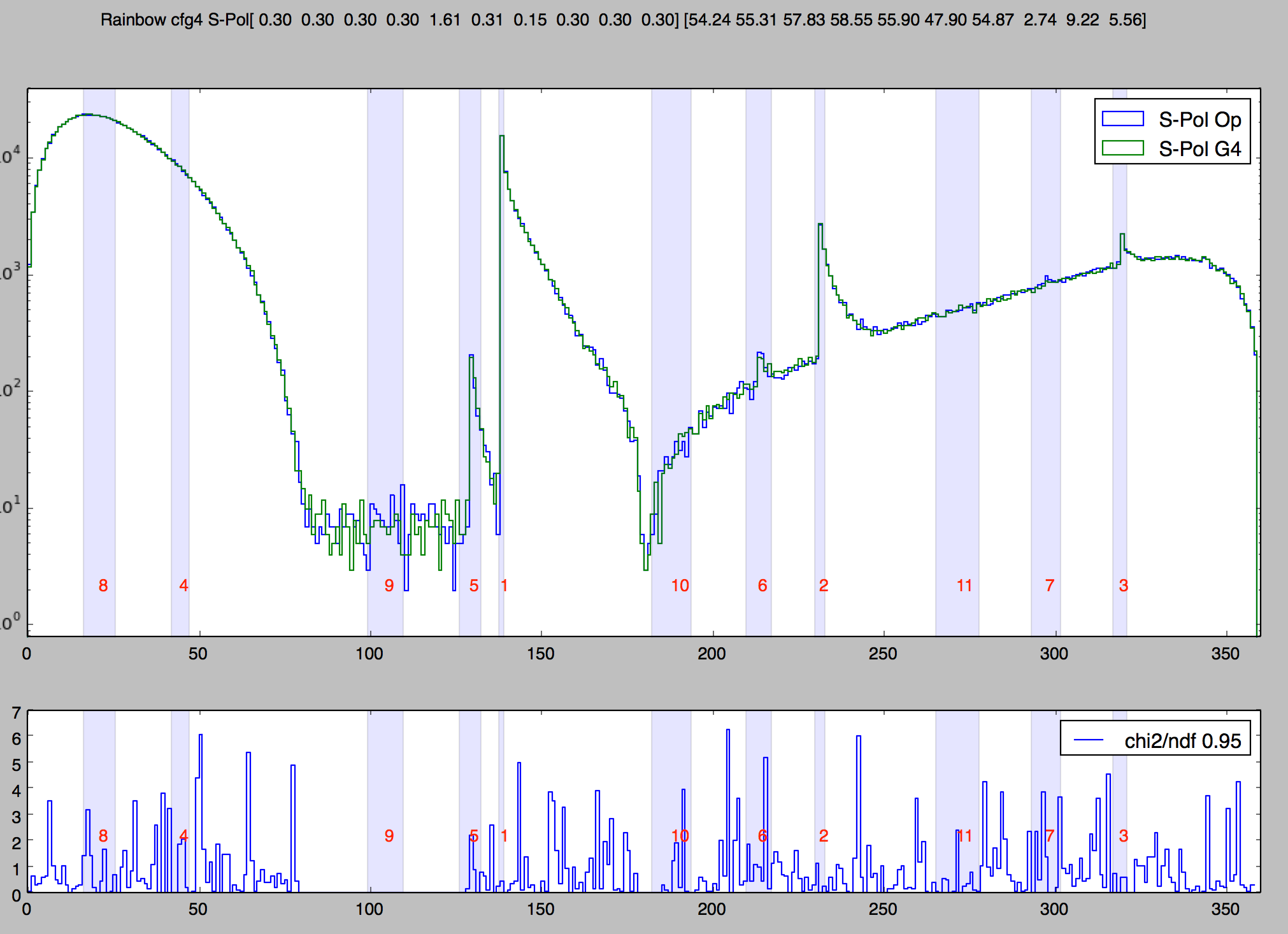
Opticks CSG Serialized into OpticksCSG format (numpy buffers, json)
// tboolean-parade
from opticks.ana.base import opticks_main
from opticks.analytic.csg import CSG
args = opticks_main(csgpath="$TMP/$FUNCNAME")
container = CSG("box", param=[0,0,0,1200], boundary=args.container, poly="MC", nx="20" )
a = CSG("sphere", param=[0,0,0,100])
b = CSG("zsphere", param=[0,0,0,100], param1=[-50,60,0,0])
c = CSG("box3",param=[100,50,70,0])
d = CSG.MakeTrapezoid(z=100, x1=80, y1=100, x2=100, y2=80)
e = CSG("cylinder",param=[0,0,0,100], param1=[-100,100,0,0])
f = CSG("disc",param=[0,0,0,100], param1=[-1,1,0,0])
g = CSG("cone", param=[100,-100,50,100])
h = CSG.MakeTorus(R=70, r=30)
i = CSG.MakeHyperboloid(r0=80, zf=100, z1=-100, z2=100)
j = CSG.MakeIcosahedron(scale=100.)
prims = [a,b,c,d,e,f,g,h,i,j]
... // setting translations
CSG.Serialize([container] + prims, args.csgpath ) <-- write trees to file
- imported into C++ nnode tree by NCSG
Compare Opticks/Geant4 Simulations with Simple Lights/Geometries
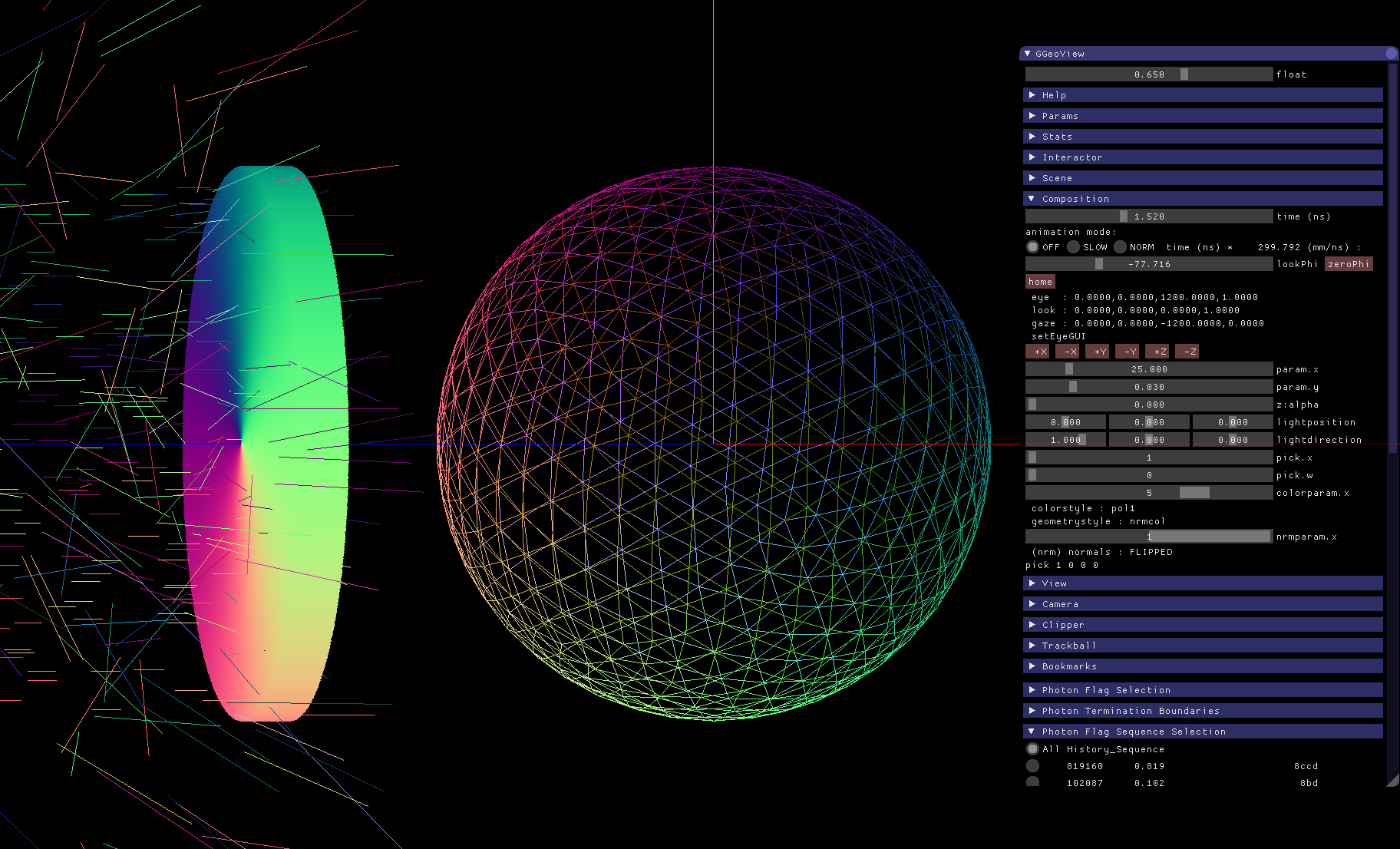
1M Photons -> Water Sphere (S-Polarized)
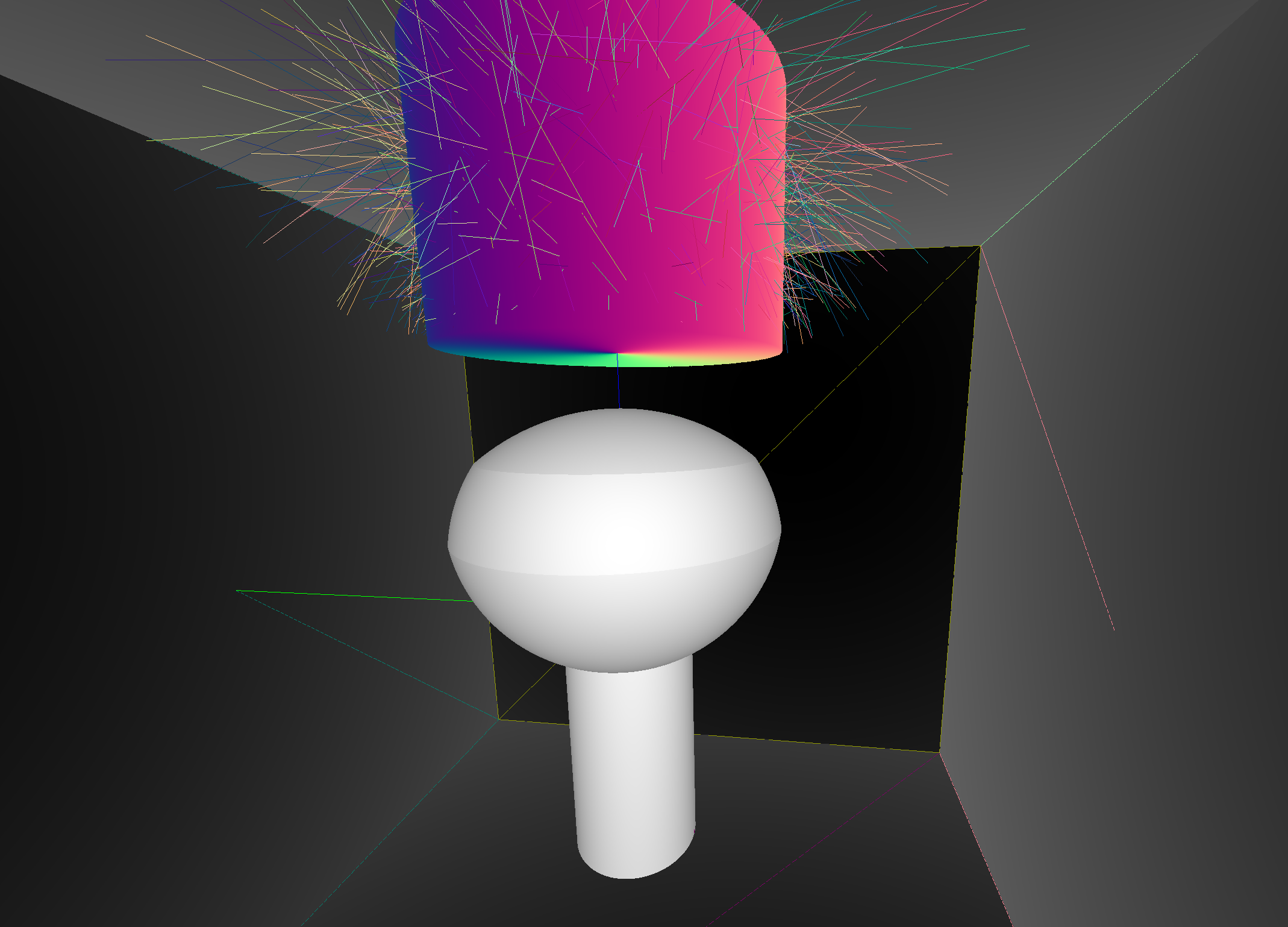
0.5M Photons -> Dayabay PMT

- Photon step records
- 128 bit per step : highly compressed position, time, wavelength, polarization vector, material/history codes
- Photon flag sequence
- 16x 4-bit step flags recorded in uint64 sequence, indexed using Thrust GPU sort (1M indexed ~0.040s)
Sequence index -> interactive OpenGL selection of photons by flag sequence
